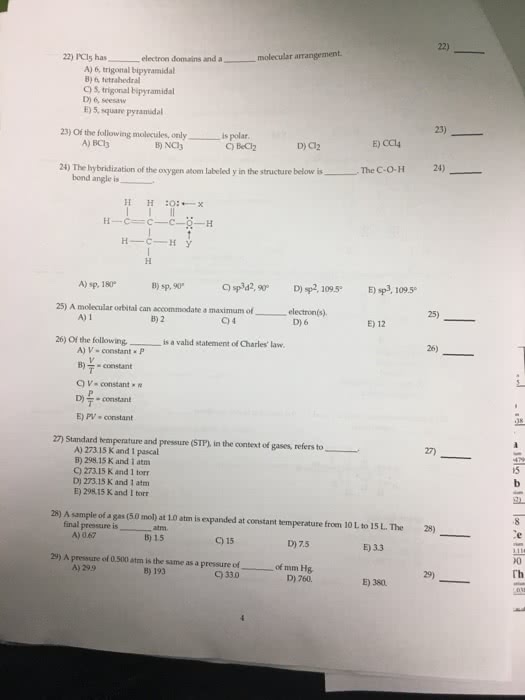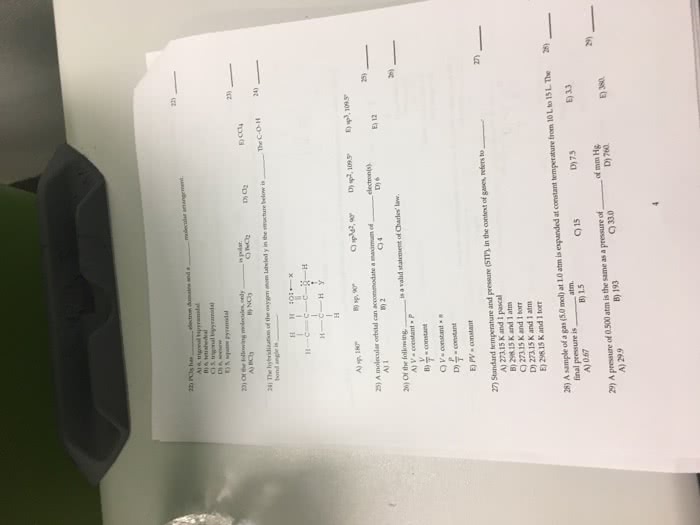01:160:159 Lecture Notes - Lecture 5: Ap Chemistry, Torr, Barometer

AP Chemistry
A. Allan
Chapter 5 - Gases
5.1 Pressure
A. Properties of gases
1. Gases uniformly fill any container
2. Gases are easily compressed
3. Gases mix completely with any other gas
4. Gases exert pressure on their surroundings
a. Pressure = force/area
B. Measuring barometric pressure
1. The barometer
a. Inventor - Evangelista Torricelli (1643)
2. Units
a. mm Hg (torr)
(1) 760 torr = Standard pressure
b. newtons/meter2 = pascal (Pa)
(1) 101,325 Pa = Standard pressure
c. atmospheres
(1) 1 atmosphere = Standard pressure
5.2 The Gas Laws of Boyle, Charles, and Avogadro
A. Boyle's Law (Robert Boyle, 1627 - 1691)
1. the product of pressure times volume is a constant, provided the
temperature remains the same
PV = k
a. P is inversely related to V
b. The graph of P versus V is hyperbolic
c. Volume increases linearly as the pressure decreases (1/P)
2. At constant temperature, Boyle's law can be used to find a new
volumes or a new pressure
a. P1V1 = k = P2V2
P1V 1
=
P2V 2
or
P1
=
V
2
P2
V
1
3. Boyle's law works best at low pressures
4. Gases that obey Boyle's law are calledIdeal gases
B. Charles' Law (Jacques Charles, 1746 - 1823)
1. The volume of a gas increase linearly with temperature provided the
pressure remains constant
a. V = bT V/T = b
(1) V1/T1 = b = V2/T2
V
1
=
V
2
or
V
1
=
T1
V 2
T
1
T
2
T 2
find more resources at oneclass.com
find more resources at oneclass.com

b. Temperature must be measured in degrees Kelvin
(1) K = °C + 273
(2) 0 K is "absolute zero"
C. Avogadro's Law Amedeo( Avogadro, 1811)
1. For a gas at constant temperature and pressure, the volume is directly
proportional to the number of moles, n
a. V = an V/n = a
(1) V1/n1 = a = V2/n2
V 1 = V 2
n1 n2
5.3 The Ideal Gas Law
A. Derivation from existing laws
1. V = k/P V = bT V = an
= ( )( )( )æ Tn ö
V k b a ç ÷
è P ø
2. Constants k, b, a are combined into universal gas constant, R
V =
nRT
or PV = nRT
P
R = 0.0826
L atm
K mol
B. Limitations of the Ideal Gas Law
1. Works well at low pressures and high temperatures
2. Most gases do not behave ideally above 1 atm pressure
3. Does not work well near the condensation conditions of a gas
C. Solving for new volumes, temp or pressure (n remaining constant)
1. Combined law (from general chem)
2.
P
1
V
1
=
n R
=
P
2
V
2
or
P
1
V
1
=
P
2
V
2
T
1
T
2
T
1
T
2
æ P öæT ö
V
2 =V
ç
1
֍
2
÷
1
ç
P2
֍
÷
è
øè
T
1
ø
find more resources at oneclass.com
find more resources at oneclass.com
Document Summary
5. 2 the gas laws of boyle, charles, and avogadro: boyle"s law (robert boyle, 1627 - 1691, the product of pressure times volume is a constant, provided the temperature remains the same. V/t = b (1) v1/t1 = b = v2/t2. V 1 = v 2 or v 1 = t1. V/n = a (1) v1/n1 = a = v2/n2 . 5. 3 the ideal gas law: derivation from existing laws, v = k/p v = bt. P : constants k, b, a are combined into universal gas constant, r nrt. V 2: standard temperature and pressure (stp) 5. 4 gas stiochiometry: 0 c, 273 k, 760 torr, 1 atm, molar volume, one mole of an ideal gas occupies 22. 42 liters of volume at stp, things to remember. Density = mass volume n = grams of subs tan ce molar mass. V: ptotal = n1 r t n2 r t.



